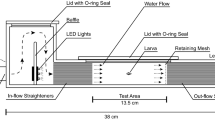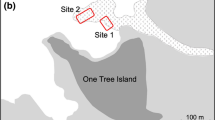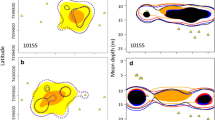Abstract
Larval behaviour is important to dispersal and settlement, but is seldom quantified. Behavioural capabilities of larval Lutjanus carponotatus in both offshore pelagic and reef environments at Lizard Island, Great Barrier Reef were observed in situ to determine if they were sufficient to influence dispersal. Offshore, larvae swam with higher directional precision and faster on the windward side of the island (28 cm.s−1) than on the leeward side (16 cm s−1). Most larvae swam directionally. Mean swimming directions were southerly in the windward area and northerly in the leeward area. Larvae avoided the surface and remained mostly between 3–15 m. Larvae released near reefs were 2–3 times faster swimming away from reefs (19 cm s−1) than swimming toward or over them (6–8 cm s−1). Speed swimming away was similar to that offshore. Of 41 larvae released near reefs, 73% reached the reef, 59% settled, and 13% of those reaching the reef were eaten. Larvae settled onto hard and soft coral (58%), topographic reef features (29%) and sand and rubble (13%). Settlement depth averaged 5.5 m (2–8 m). Before settling larvae spent up to 800 s over the reef (mean 231 s) and swam up to 53 m (mean 14 m). About half of the larvae interacted with reef residents including predatory attacks and aggressive approaches by residents and aggressive approaches by settling larvae. Settlement behaviour of L. carponotatus was more similar to a serranid than to pomacentrids. Settlement-stage larvae of L. carponotatus are behaviourally capable, and have a complex settlement behaviour.




Similar content being viewed by others
References
Allen GR (1985) Snappers of the world. FAO Species Catalogue, FAO, Rome, 6:1–208+228 plates
Allen GR, Talbot FH (1985) Review of the snappers of the genus Lutjanus (Pisces: Lutjanidae) from the Indo-Pacific, with the description of a new species. Indo-Pac Fishes 11:1–87
Armsworth PR (2000) Modelling the swimming response of late stage larval reef fish to different stimuli. Mar Ecol Prog Ser 195:231–247
Batschelet E (1981) Circular statistics in biology. Academic Press, London
Connell SD (1998) Patterns of piscivory by resident predatory reef fish at One Tree Reef, Great Barrier Reef. Mar Freshwat Res 49:25–30
Doherty P, Kingsford M, Booth D, Carleton J (1996) Habitat selection before settlement by Pomacentrus coelestis. Mar Freshwat Res 47:391–399
Doherty PJ, Dufour V, Galzin R, Hixon MA, Meekan MG, Planes S (2004) High mortality during settlement is a population bottleneck for a tropical surgeonfish. Ecology 85:2422–2428
Dorenbosch M, van Riel MC, Nagelkerken I, van der Velde G (2004) The relationship of reef fish densities to the proximity of mangrove and seagrass nurseries. Estuar Coast Shelf Sci 60:37–48
Fisher R, Leis JM (2009) Swimming performance in larval fishes: from escaping predators to the potential for long distance migration. In: Domenici P, Kapoor BG (eds) Fish locomotion: an etho-ecological approach. Science, Enfield, pp 333–373
Fisher R, Leis JM, Clark DL, Wilson SK (2005) Critical swimming speeds of latestage coral reef fish larvae: variation within species, among species and between locations. Mar Biol 147:1201–1212
Frith CA, Leis JM, Goldman B (1986) Currents in the Lizard Island region of the Great Barrier Reef Lagoon and their relevance to potential movements of larvae. Coral Reefs 5:81–92
Kritzer JP (2004) Sex-specific growth and mortality, spawning season, and female maturation of the stripey bass (Lutjanus carponotatus) on the Great Barrier Reef. Fish Bull 102:94–107
Lecchini D, Galzin R (2005) Spatial repartition and ontogenetic shifts in habitat use by coral reef fishes (Moorea, French Polynesia). Mar Biol 147:47–58
Leis JM (1991) The pelagic phase of coral reef fishes: larval biology of coral reef fishes. In: Sale PF (ed) The ecology of fishes on coral reefs. Academic, San Diego, pp 183–230
Leis JM (2004) Vertical distribution behaviour and its spatial variation in late-stage larvae of coral-reef fishes during the day. Mar Freshwat Behav Physiol 37(2):65–88
Leis JM (2006) Are larvae of demersal fishes plankton or nekton? Adv Mar Biol 51:59–141
Leis JM (2007) Behaviour as input for modelling dispersal of fish larvae: behaviour, biogeography, hydrodynamics, ontogeny, physiology and phylogeny meet hydrography. Mar Ecol Prog Ser 347:185–193
Leis JM, Carson-Ewart BM (1997) In situ swimming speeds of the late larvae of some coral reef fishes. Mar Ecol Prog Ser 159:165–174
Leis JM, Carson-Ewart BM (1998) Complex behaviour by coral-reef fish larvae in open-water and near-reef pelagic environments. Environ Biol Fishes 53:259–266
Leis JM, Carson-Ewart BM (1999) In situ swimming and settlement behaviour of larvae of an Indo-Pacific coral-reef fish, the Coral Trout (Pisces, Serranidae, Plectropomus leopardus). Mar Biol 134:51–64
Leis JM, Carson-Ewart BM (2001) Behavioural differences in pelagic larvae of four species of coral-reef fishes between two environments: ocean and atoll lagoon. Coral Reefs 19:247–257
Leis JM, Carson-Ewart BM (2002) In situ settlement behaviour of damselfish larvae (Pisces: Pomacentridae). J Fish Biol 61:325–346
Leis JM, McCormick MI (2002) The biology, behaviour and ecology of the pelagic, larval stage of coral-reef fishes. In: Sale PF (ed) Coral reef fishes: dynamics and diversity in a complex ecosystem. Academic, San Diego, pp 171–199
Leis JM, Carson-Ewart BM (2003) Orientation of pelagic larvae of coral-reef fishes in the ocean. Mar Ecol Prog Ser 252:239–253
Leis JM, Carson-Ewart BM (eds) (2004) The larvae of Indo-Pacific coastal fishes: a guide to identification (Fauna Malesiana Handbook 2, 2nd edition), Vol 2. Brill, Leiden
Leis JM, Fisher R (2006) Swimming speed of settlement-stage reef-fish larvae measured in the laboratory and in the field: a comparison of critical speed and in situ speed. Proceedings of the 10th International Coral Reef Symposium, Okinawa:438–445
Leis JM, Sweatman HPA, Reader SE (1996) What the pelagic stages of coral reef fishes are doing out in blue water: daytime field observations of larval behaviour. Mar Freshwat Res 47:401–411
Leis JM, Hay AC, Clark DA, Chen I-S, Shao K-T (2006) Behavioral ontogeny in larvae and early juveniles of the giant trevally, Caranx ignobilis (Pisces: Carangidae). US Fish Bull 104:401–414
Leis JM, Wright KJ, Johnson RN (2007) Behaviour that influences dispersal and connectivity in the small, young larvae a reef fish. Mar Biol 153:103–117
Leis JM, Hay AC, Howarth GJ (2009) Ontogeny of in situ behaviours relevant to dispersal and connectivity in larvae of coral-reef fishes. Mar Ecol Prog Ser 379:163–179
Nakamura Y, Horinouchi M, Shibuno T, Tanaka Y, Miyajima T, Kioke I, Kurokura H, Sano M (2006) Evidence of ontogenetic migration from mangroves to coral reefs by black-tail snapper Lutjanus fulvus: stable isotope approach. Mar Ecol Prog Ser 355:257–266
Nanami A, Yamada H (2009) Seasonality, lunar periodicity of settlement and microhabitat association of juvenile humpback red snapper Lutjanus gibbus (Lutjanidae) in an Okinawan coral reef. Mar Biol 156:407–414
North E, Gallego A, Pe P (2009) Manual of recommended practices for modelling physical-biological interactions in fish early life. ICES Coop Res Rep 295:1–112
Öhman MC, Munday PL, Jones GP, Caley MJ (1998) Settlement strategies and distribution patterns of coral-reef fishes. J Exp Mar Biol Ecol 225:219–238
Pollux BJA, Verbek WCEP, Dorenbosch M, Cohchert de la Morniere E, Nagelkerken I, van der Velde G (2007) Habitat selection during settlement of three Caribbean coral reef fishes: indications for directed settlement to seagrass beds and mangroves. Limnol Oceanogr 52:903–907
Randall JE, Allen GR, Steene RC (1997) Fishes of the Great Barrier Reef and Coral Sea, vol Crawford House. Bathurst, NSW
Russell DJ, McDougall AJ (2005) Movement and juvenile recruitment of mangrove jack, Lutjanus argentimaculatus (Forsskal), in northern Australia. Mar Freshwat Res 56:465–475
Stobutzki IC, Bellwood DR (1997) Sustained swimming abilities of the late pelagic stages of coral reef fishes. Mar Ecol Prog Ser 149:35–41
Stobutzki IC, Bellwood DR (1998) Nocturnal orientation to reefs by late pelagic stage coral reef fishes. Coral Reefs 17:103–110
Sweatman HPA (1993) Tropical snapper (Lutjanidae) that is piscivorous at settlement. Copeia 1993:1137–1139
Wright KJ, Higgs DM, Cato DH, Leis JM (2009) Auditory sensitivity in settlement-stage larvae of coral reef fishes. Coral Reefs
Zar JH (1996) Biostatistical Analysis, 3rd ed. Prentice Hall, Upper Saddle River, N.J.
Acknowledgements
The field work reported here was supported by Australian Research Commission grants to JML (A19530997, A19804335, DP0345876) and was done under Australian Museum Animal Care and Ethics Committee approvals and Great Barrier Reef Marine Park Authority permits. We thank the many people who aided in obtaining these field data, especially, B Carson-Ewart and A Hay (who also took the photo in Fig. 2), and the staff of the Lizard Island Research Station for making our field work possible. Thanks to S Bullock and M Yerman for editorial assistance. The analysis of data and preparation of this manuscript were supported by a Marine and Topical Scientific Research Facility grant to JML and a student internship from University Pierre et Marie Curie (Paris VI) to GQ.
Author information
Authors and Affiliations
Corresponding author
Rights and permissions
About this article
Cite this article
Quéré, G., Leis, J.M. Settlement behaviour of larvae of the Stripey Snapper, Lutjanus carponotatus (Teleostei: Lutjanidae). Environ Biol Fish 88, 227–238 (2010). https://doi.org/10.1007/s10641-010-9633-x
Received:
Accepted:
Published:
Issue Date:
DOI: https://doi.org/10.1007/s10641-010-9633-x




